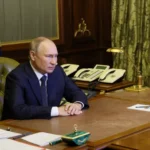Russia recently Vetoed a draft resolution pushed by the United States and Japan that aims to avoid a nuclear arms race in space. In a 12-member UN Security Council, 13 of the members voted in favour while Russia voted against and China abstained from the resolution. This shows that there is a loophole in the ongoing arms control efforts in general and space arms control in specific. If passed, the Council would have called on all nations “to refrain from actions contrary to that objective and to the relevant existing treaties in the interest of maintaining international peace and security and promoting international cooperation”.
On the other hand, Russia and China have also proposed an amendment to the U.S.-Japan draft which calls on countries “to prevent for all time the placement of weapons in outer space, and the threat of use of force in outer spaces.” U.S. opposed the resolution but both Russia and China demands a ban on the placement of any kind of weapon not just WMD. All of these show a lack of trust between major players in the existing arms-control obligations. It also underscores the challenges in achieving censuses on important disarmament issues.
The history of Space exploration by the U.S. and the Soviet Union started during the Cold War as a result of which Sputnik Satellite was developed in 1957.
Similarly, the Outer Space Treaty was signed by both countries in 1967 which prevents the placement of nuclear weapons in orbit. It also established the principles of outer space including the usage of space weapons for peaceful purposes only. Not only this, both the U.S. and the Soviet Union also engaged in strategic talks known as Strategic Arms Limitation Talks (SALT). This time, the talks also included space based technologies that have dual-use capabilities.
The Strategic Arms Reduction Treaties (START) also focuses on the reduction of strategic weapons and overall arms control efforts. Lastly, the Anti-Ballistic Missile (ABM) Treaty was signed in 1972 which the U.S. withdrew in 2002 citing the need to counter nuclear threats from Iran and North Korea. This move had a destabilizing effect on the future of arms control in contemporary times.
In recent years, both Russia and the U.S. are developing several space capabilities including space-based missile defences and anti-satellite weapons making the militarization of space more intense. The White House has accused Russia of developing a troubling anti-satellite weapon capability in February which was later denied by President Putin by stating that the country has developed capabilities similar to those of the U.S.
The recent Veto by Russia has sparked different reactions globally. US Ambassador to the UN Linda Thomas-Greenfield said: “This is not the first time Russia has undermined the global non-proliferation regime. Over the past few years, Russia has irresponsibly invoked dangerous nuclear rhetoric and walked away from several of its arms control obligations.” Similarly, U.S. National Security Advisor Jake Sullivan said: “The United States assesses that Russia is developing a new satellite carrying a nuclear device. If Putin has no intention of deploying nuclear weapons in space, Russia would not have vetoed this resolution.”
The Global Space race became more intense when the U.S. and Russia started developing rockets that could carry nuclear warheads.
The investment in advanced missiles and rockets resulted in a shift from an arms race to a space race and has become an ideological and political contest between both nations. The major issue is the invention of dual-use technologies i.e. GPS which is mainly used for civilian purposes but has a military use as well. Efforts to sabotage or reduce each other’s space-based infrastructure are ongoing in the ever-evolving space race. It is also worth noting that this type of space race is harmful to the security environment of the world. The use of force by any state could trigger its adversary to react resulting in a war like situation which is not only dangerous for the satellites but could also impact the vital communications, commercial, and national security services.
In addition, the space race is not limited to U.S. and Russia. China which has abstained from the UN draft resolution is reluctant to sit on the table for talks revolving around disarmament.
U.S. officials often blame China for the lack of space collaboration. However, the 2011 Wolf Amendment which prohibits NASA from using government funds in a bilateral cooperation with China negatively impacted the regular exchanges. China’s main concern is that the U.S. refuses to share information about its sensitive technology but expects the opposite from other nations.
Also Read: Dynamics of Four-Sided Saga in Asia-Pacific Region
Despite these rifts, the U.S. had established a civil space dialogue mechanism where both sides exchange views on a wide range of areas concerning outer space. The updates regarding recent space strategies and policies are also shared on this platform. Unfortunately, only three dialogues have happened until now but the fourth one has not yet convened which brings us to the point that the current arms control mechanism is flawed and requires a careful approach.
The future of arms control is uncertain. States have recognized the need to prevent the weaponization of space because of the destabilizing effect it could have on International relations. The Outer Space Treaty is one such example that shows a commitment to maintaining space as a peaceful domain. However, the advancement in technology coupled with Artificial intelligence and periods of tension and competition is making it more intense.
Space has become an attractive playground for military activities and many technologies are being developed by states which could be used for offensive purposes. This situation has raised concerns about the possibility of space arms race threatening the global nuclear order. The current environment demands a need for fresh arms control agreements which ultimately depends on the willingness of the states to engage in dialogue and cooperation. There is also a need to create a framework for managing future conflicts in space. Ostensibly, confidence-building measures, communication, and understanding between the U.S., Russia, and China are essential for their peaceful co-existence in space.
The views expressed in this article are the author’s own. They do not necessarily reflect the editorial policy of the South Asia Times.
Mommna Tahir is an Independent Researcher based in Islamabad, Pakistan. She completed her MPhil in Strategic Studies from National Defence University (NDU). Her areas of interests include Peace Prospects across South Asia, Arms control, Digital Revolution, Foreign Affairs, Diplomacy and Public Policy. She can be reached at mommnamalik80@gmail.com.

![Russia's defense ministry tests on 15 July 2020 posed no threat to other space equipment, according to the country's foreign ministry. [via Reuters]](https://southasiatimes.org/wp-content/uploads/2024/05/a9e3d473c95c467fa0fff93c0fb0bfe7_18.webp)



Add a Comment